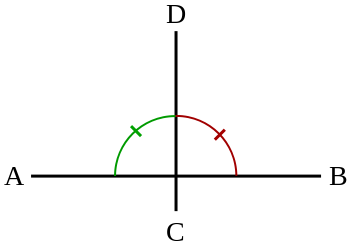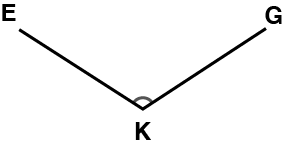Geometry covers a vast range of topics. In this lesson, we’ll learn vocabulary for a fundamental aspect of geometry: angles.
- angle
- intersect
- ray
- endpoint
- vertex
- degree
- acute angle
- right angle
- obtuse angle
- plane
- translation
- rotation
- reflection
- dilation
- congruent shape
- similar shape
Angles
An angle is the space between either:
| two lines that intersect |
 |
In this picture, AB and CD are lines that intersect (cross). The spaces between are angles. For example, the space between A and D that's marked in green is an angle. |
| two rays that share an endpoint |
 |
EK and GK are rays. Rays are "half lines." This means that they continue infinitely in one direction but have an endpoint. K is the endpoint for both EK and GK. The space between E and G is an angle.
When two rays share an endpoint, the endpoint is called a vertex. K is a vertex. |
An angle is measured in degrees (like temperature!). A straight line is 180°. An angle is between 0° and 180°.
There are special names for three different kinds of angles. A right angle is exactly 90°. An acute angle is less than 90°. An obtuse angle is more than 90°.

Congruent and similar shapes
It's important to remember that angles don't sit in nothingness. 2D figures like angles, circles, or triangles exist on a plane. A plane is an infinitely tall and wide, flat, 2D surface. Shapes can move on the plane. There are several ways a shape can move, and each way has a special name.

- A translation is when a shape moves in one direction, but it doesn't flip or turn.
- A rotation is when a shape "turns" or rotates.
- A reflection is when a shape "flips" to make a mirror image of itself.
Unlock full access by logging in. Registered users can explore the entire lesson and more.